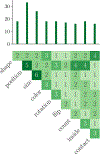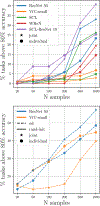A Benchmark for Compositional Visual Reasoning
- PMID: 37534101
- PMCID: PMC10396074
A Benchmark for Compositional Visual Reasoning
Abstract
A fundamental component of human vision is our ability to parse complex visual scenes and judge the relations between their constituent objects. AI benchmarks for visual reasoning have driven rapid progress in recent years with state-of-the-art systems now reaching human accuracy on some of these benchmarks. Yet, there remains a major gap between humans and AI systems in terms of the sample efficiency with which they learn new visual reasoning tasks. Humans' remarkable efficiency at learning has been at least partially attributed to their ability to harness compositionality - allowing them to efficiently take advantage of previously gained knowledge when learning new tasks. Here, we introduce a novel visual reasoning benchmark, Compositional Visual Relations (CVR), to drive progress towards the development of more data-efficient learning algorithms. We take inspiration from fluid intelligence and non-verbal reasoning tests and describe a novel method for creating compositions of abstract rules and generating image datasets corresponding to these rules at scale. Our proposed benchmark includes measures of sample efficiency, generalization, compositionality, and transfer across task rules. We systematically evaluate modern neural architectures and find that convolutional architectures surpass transformer-based architectures across all performance measures in most data regimes. However, all computational models are much less data efficient than humans, even after learning informative visual representations using self-supervision. Overall, we hope our challenge will spur interest in developing neural architectures that can learn to harness compositionality for more efficient learning.
Figures







References
-
- Agrawal Aishwarya, Kembhavi Aniruddha, Batra Dhruv, and Parikh Devi. C-vqa: A compositional split of the visual question answering (vqa) v1. 0 dataset. arXiv preprint arXiv:1704.08243, 2017.
-
- Bakhtin Anton, van der Maaten Laurens, Johnson Justin, Gustafson Laura, and Girshick Ross. Phyre: A new benchmark for physical reasoning. Advances in Neural Information Processing Systems, 32, 2019.
-
- Barrett David, Hill Felix, Santoro Adam, Morcos Ari, and Lillicrap Timothy. Measuring abstract reasoning in neural networks. In International conference on machine learning, pages 511–520. PMLR, 2018.
-
- Mikhail Moiseevich Bongard. The recognition problem. Technical report, FOREIGN TECHNOLOGY DIV WRIGHT-PATTERSON AFB OHIO, 1968.
-
- Bowman Samuel R, Manning Christopher D, and Potts Christopher. Tree-structured composition in neural networks without tree-structured architectures. arXiv preprint arXiv:1506.04834, 2015.
Grants and funding
LinkOut - more resources
Full Text Sources
Miscellaneous
